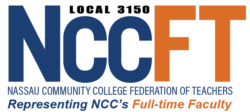 Enrollment & Class Offerings
Enrollment & Class Offerings
As I write this post, Nassau Community College is facing another 6% decrease in student enrollment, compared to last year at this time. Although full-time faculty schedules are mostly intact, many of the specialty courses that we have developed, which allow our students to explore a deeper understanding of the world, are being cancelled due to low enrollment. This low enrollment does not reflect a lack of student interest, but rather a reduction in the pool of students who might choose to take those courses. The distinction is a crucial one and we need to make sure it helps to inform the kinds of discussions about our situation that need to be taking place across campus at all levels—Department meetings, meetings of the NCCFT, AFA, CSEA and NCCAA, Senate meetings, Academic Chairs, Academic Affairs, Student Services, Student Government, Cabinet meetings and the Board of Trustees. Within and across all those different campus constituencies, we need to be talking openly and honestly not only about how to deal with the current state of our enrollment, but also about recruitment and retention more broadly.
Especially because we are in the midst of searching for a new college president, it is imperative that we develop a consensus for how to deal with these issues. If we are to have any credibility at all with the new administration, we must be honest brokers in identifying not only the problems, but also, more importantly, in offering plausible solutions to the myriad issues facing us. We need to present our new President, whomever he or she may be, with such a well-thought-out analysis and plan-of-action that he or she will be eager to join in our efforts as our leader. It would be a missed opportunity, a truly unfortunate mistake, to wait for the new administration to begin their tenure by trying to reshape our culture and future as a result of our inaction.
In addition to discussing creative ideas to stop the spiral of declining enrollment, we must also address the reduction accompanying this decline in the kinds of course offerings I mentioned above. I am not talking about the reduction in multiple sections of the same course, but of discipline-specific and/or general-interest specialty courses—includinglearning communities, honors and paired courses—that faculty members have created and that our colleagues have vetted as appropriate and necessary for the enrichment of our students’ lives. It is essential that we reach a consensus on how to determine a cost-benefit analysis with respect to these course offerings. How do we place a financial value on the (personal, scholarly, professional) benefits these students receive by taking the course? How do we place a financial value on what those students will then be able to offer society in return? Or, to make those questions more concrete, given the decline in our enrollment, and knowing that the value of a given class is not always best measured in terms of dollars and cents, how many students should be in those classes in order for them to run?
I have, for example, heard from the Academic Chairs that Deans have been presenting them with “breakeven enrollment” class sizes. In other words, the chairs have told me, Deans are deciding whether or not to run classes based on how close the tuition paid by the students in those classes comes to covering the cost of paying faculty members to teach them. This kind of breakeven analysis with respect to class size sets a dangerous precedent. To take this position with any kind of consistency, the college would need to engage in an MBA type of profit-loss analysis with respect not only to class size and course offerings, but also to academic programs, support personnel and other aspects of the campus. If you remember, this idea was floated during a past administration, was wholeheartedly rejected by the faculty, and the ensuing struggle began the descent that culminated in our only recently resolved Middle States crisis.
Perhaps more to the point, though, at the current time, when the college rightly bemoans the fact it has to rely more and more on student tuition to balance its books, it is unacceptable to use student tuition as the sole measure of whether or not the college can afford to run any given course. How do the other sources of college funding—State FTE reimbursements, chargebacks and the local sponsor contribution—figure into this equation? I am not suggesting that I have the answer. Rather, I am arguing that we need to discuss this issue honestly and openly in relation to the college’s educational vision and mission, and not merely in terms of a limited, dollars-and-cents perspective. (There is also the issue that using this kind of breakeven analysis for course offerings could be used as a backdoor for replacing full-time with adjunct assignments. Adjunct assignments would obviously have a lower breakeven point and would, therefore, in theory, allow for smaller class sizes, making them seem, from a purely financial perspective, like a win-win proposition. I don’t believe that’s what is happening here, but we would be naïve not to note the possibility.)
NCC & Open Education Resources
As you may be aware, SUNY is providing grant money to Community Colleges to implement the Open Education Resources initiatives. SUNY has contracted with Lumina to oversee this program and the NCCFT has appointed Prof. Darleen Braunshweiger to represent us on the college’s adhoc committee investigating and implementing this new paradigm on campus. There are many aspects to this program, including cost, oversight, and intellectual property rights, which must be addressed and agreed upon with potential contractual language. As we begin to sort through the details, we will discuss this in more depth.
The State Budget
Now that Governor Cuomo has announced his agenda in his State of the State address, along with his budget for the coming fiscal year, NYSUT is organizing the annual SUNY HigherEd lobby day. (You can read NYSUT’s preliminary budget analysis here.) Although NYSUT believes we will have a more “friendly” environment in the State Senate during this session, there are many competing entities that feel the same way, and all of them will be lobbying for their constituencies. The NCCFT Political Action Committee, chaired by Prof. Uzo Osuno will lead a contingent of faculty to Albany on February 11thand 12thin order to meet with selected NYS Assembly members and NYS Senators to promote fair funding for SUNY.
As usual, the four-year campuses and community colleges in both SUNY and CUNY have various and unique needs. Nonetheless, the NYSUT HigherEd Policy Council (HEPC) met earlier this month in New York City. Prof. Donna Hope and myself attended and we are pleased to report that the HEPC agreed that each constituency group will support the groups’ requests. In addition, the HEPC agreed that we would not support the SUNY Hybrid funding model for Community Colleges due to the lack of any coherent plan, the absence of a legislative proposal, or any significant support in the legislature. Instead, we will support an increase in FTE funding of $250 to bring the present $2,847/FTE to $3,097/FTE with a new floor of $3,000 per FTE.
Professor On Wheels
Finally, the NCCFT Executive Committee is in the process of scheduling our Spring 2019 Professor on Wheels program at the East Meadow/Levittown Senior Center. The classes are usually scheduled to be held during club hour. This is an exciting new initiative and we look forward to hearing from any faculty member who wants to participate. You may contact the NCCFT office or donna.hope@ncc.edufor more information.
I wish you a happy and healthy New Year and look forward to hearing from you if you have any questions or concerns.

One Response
Frank notes the 6% decrease in enrollment that NCC has experienced this year. We should be cognizant of the fact that we are not unique in this regard as it has been reported that, with rare exceptions, our neighboring institutions have also experienced the same enrollment declines. How much of this decline is the consequence of changing demographics in Nassau County? Is this a function of rising student debt or the stagnation of incomes relative to inflation? Does the fact that New York State continues to negate its commitment to pay the appropriate share of our budget contribute to a rising tuition expense? (How much of this is attributable to institutional racism, i.e., as the numbers of individuals of color attend our public institutions, the governmental support of higher education has failed to keep pace.)
While not all of us can attend SUNY HigherEd Lobby Day in Albany, we all can make our contribution to the cause. Telephone calls to our state legislators as our colleagues are meeting with these individuals can magnify our message. Perhaps our NCCFT leaders can supply us with their appointment schedule with legislators for that purpose. I have successfully used that method to reinforce the message my library colleagues are offering when they visit Albany for Library Day.